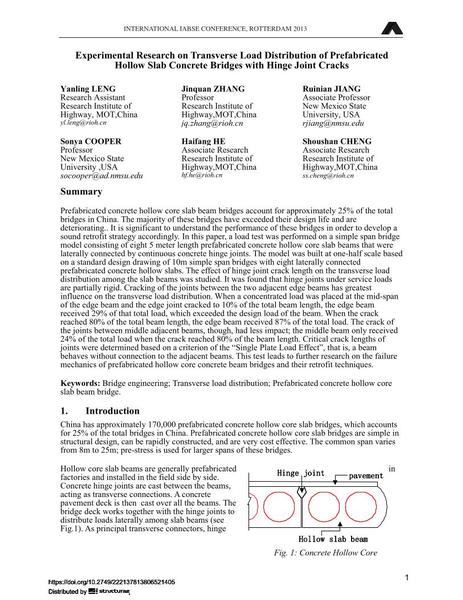Experimental Research on Transverse Load Distribution of Prefabricated Hollow Slab Concrete Bridges with Hinge Joint Cracks

|
|
|||||||||||
Bibliographic Details
| Author(s): |
Yanling Leng
Jinquan Zhang Ruinian Jiang Sonya Cooper Haifang He Shoushan Cheng |
||||
|---|---|---|---|---|---|
| Medium: | conference paper | ||||
| Language(s): | English | ||||
| Conference: | IABSE Conference: Assessment, Upgrading and Refurbishment of Infrastructures, Rotterdam, The Netherlands, 6-8 May 2013 | ||||
| Published in: | IABSE Conference, Rotterdam, May 2013 | ||||
|
|||||
| Page(s): | 536-537 | ||||
| Total no. of pages: | 7 | ||||
| Year: | 2013 | ||||
| DOI: | 10.2749/222137813806521405 | ||||
| Abstract: |
Prefabricated concrete hollow core slab beam bridges account for approximately 25% of the total bridges in China. The majority of these bridges have exceeded their design life and are deteriorating.. It is significant to understand the performance of these bridges in order to develop a sound retrofit strategy accordingly. In this paper, a load test was performed on a simple span bridge model consisting of eight 5 meter length prefabricated concrete hollow core slab beams that were laterally connected by continuous concrete hinge joints. The model was built at one-half scale based on a standard design drawing of 10m simple span bridges with eight laterally connected prefabricated concrete hollow slabs. The effect of hinge joint crack length on the transverse load distribution among the slab beams was studied. It was found that hinge joints under service loads are partially rigid. Cracking of the joints between the two adjacent edge beams has greatest influence on the transverse load distribution. When a concentrated load was placed at the mid-span of the edge beam and the edge joint cracked to 10% of the total beam length, the edge beam received 29% of that total load, which exceeded the design load of the beam. When the crack reached 80% of the total beam length, the edge beam received 87% of the total load. The crack of the joints between middle adjacent beams, though, had less impact; the middle beam only received 24% of the total load when the crack reached 80% of the beam length. Critical crack lengths of joints were determined based on a criterion of the “Single Plate Load Effect”, that is, a beam behaves without connection to the adjacent beams. This test leads to further research on the failure mechanics of prefabricated hollow core concrete beam bridges and their retrofit techniques. |
||||
| Keywords: |
bridge engineering Transverse load distribution Prefabricated concrete hollow core slab beam bridge
|
||||
